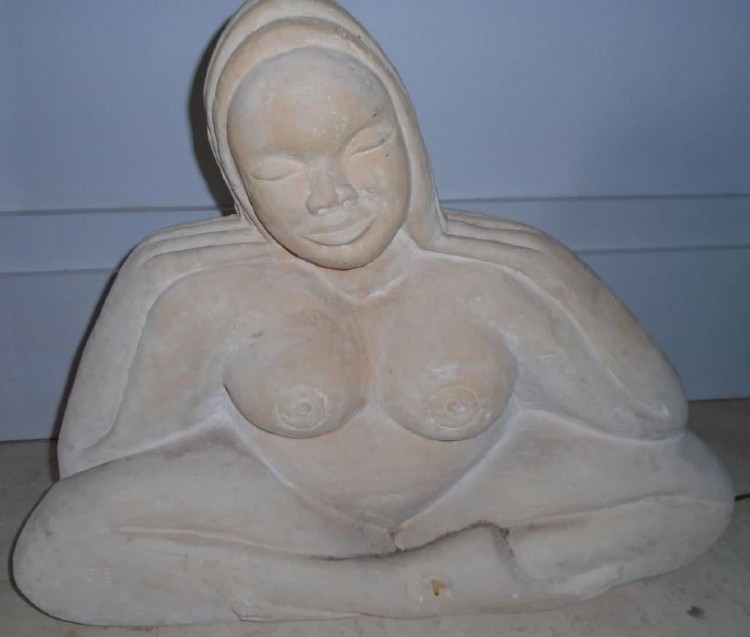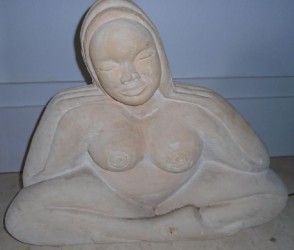
MEMPHIS, Tenn. (AP) – The artist Luther Hampton sits at a table next to the bar at B.B. King’s Blues Club on Beale, drawing his own face on the sketchbook in front of him. When someone sits down across from him, after an exchange of pleasantries, he asks for more coffee, turns the page and says he’s one of the “fastest sketch artists in America” – he can draw the visitor’s face before the server returns with his coffee. He does, and it’s a good likeness.
But Luther Hampton’s niche in the tourist trade on Beale doesn’t describe his significance as an artist. A few blocks west of B.B. King’s, at the Tops Gallery – a dazzling, small art space in what used to be a basement coal-storage room near Front Street – there’s a revelatory collection of Hampton’s work as a sculptor.
Four of 13 pieces in the Tops show will soon go to the collections at Memphis Brooks Museum of Art and the Baltimore Museum of Art. Another piece, at a companion exhibition installed in the Tops space at Madison Avenue Park, will go to the Tennessee State Museum.
Collectors who loaned works for the Tops show are Dr. James C. Varner, an orthopedic surgeon, and Elliot Perry, one-time NBA player and now the color commentator for Grizzlies radio broadcasts. As Varner and Elliot tell the story, Hampton’s brilliance is clear to anyone who sees his work from the 1960s to the 1990s, roughly the time covered by the exhibition.
Perry, a Memphis high school and college basketball star who went on to 10 years in the NBA and now is director of player support for the Grizzlies, has also been a dedicated art collector for 20 years. He ran into Hampton in 1998 or 1999, about the time he began acquiring art.
“I met him when I was going to a Black-owned gallery that used to be on Beale. He was telling me he was a sculptor, and I just thought he was a guy on the street. He asked if he could show me his work and when I came back to the gallery on Beale, he actually had slides.
“Once I saw them, I said, ‘Man, this cat is incredible.’”
Perry focuses on African American artists and says he had been reading about the celebrated sculptors Elizabeth Catlett and Marion Perkins, “and I thought Luther was just as good.
“His wood, sandstone, marble, they’re great works and compelling. I’ve had the privilege of watching him sculpt,” Perry said, “and to watch him work, to get the body structure right, the anatomy of the body, the perfect symmetry.”
Perry is especially fond of one Hampton wood piece in the show that he watched come into being in 2001 – a small, slender figure of a woman 26 inches tall and 2 by 4 inches at the base. “He was just working on a piece of wood he found. She was just so elegant, she was just beautiful, and once he put the linseed oil on it, the wood grain came out.”
“The level of talent Luther had in the ’60s, ’70s and ’80s, those are master sculptures and belong in museums,” Perry said.
Art museums taking notice
Varner, who is donating Hampton’s work to the museums, has the same opinion.
“He has a legacy that needs to be recognized and memorialized in my opinion,” Varner said. “The public needs to see it.”
Varner first learned about Hampton from the sculptor John McIntire, a retired Memphis College of Art professor and venerated figure in the Memphis art scene. In the late 1960s, McIntire encouraged Hampton to attend what was then Memphis Academy of Art, from which Hampton graduated in 1973.
About 15 years ago, a Downtown antique store owner asked Varner if he wanted to buy some of Hampton’s pieces, and he bought all 20 or so. “I thought the collection needed to stay together,” he said. Varner was drawn to what he characterized as Hampton’s “figurative form of abstraction.”
“When you start talking sculpture, to do reductive work, you have to have space, the tools, access to the medium, wood, stone, marble.
“Luther told me one time that some of the large wooden pieces were from lumber he salvaged from the Mississippi River,” Varner said.
“He’s a special talent; he needs to be recognized. He’s going to be on the bigger stage when these pieces are introduced at the Brooks, the Tennessee museum and the Baltimore museum.”
Varner says Matt Ducklo, owner of Tops Gallery, and Emily Ballew Neff, Brooks Museum director, asked the same question when they first saw Hampton’s work: “Gosh, where has this stuff been?”
In a prepared statement about Brooks’ new Hampton acquisitions, Neff said, “Luther Hampton’s work shows Memphis’ contributions to the story of African American art and we look forward to placing his work within this broader national and international context.” The museum already owned a Hampton piece called Two Heads, the director noted.
Heather Nickels, a curatorial fellow in African American Art and Art of the African Diaspora at Brooks, said that like Elizabeth Catlett, Hampton’s work had a “continued focus on one particular subject: Black women.” (Brooks will open a show in June titled “Persevere & Resist: The Strong Black Women of Elizabeth Catlett.”)
Neff described Tops Gallery, and its owner and curator Ducklo, as “an important part of the arts ecosystem in our city,” adding, “We always enjoy going by Tops to see what Matt has brought to show; he does such a great job on behalf of all of us in Memphis.”
Ducklo, a photographer and Memphis native who worked for nearly 10 years in New York City, was among the pioneers featured by the entertainment news site Vulture in 2018 under the title, “Ten Galleries Whose Founders Quit the Big City to Become Cultural Trailblazers in the Heartland.”
Focus on the female figure
In his essay for the Hampton show, Ducklo also calls attention to Hampton’s focus on the female figure. “Fourteen of the works in this exhibition are representations of Black women. Young and old, alluring and stolid. Archetypal. All strong.”
And having befriended Hampton, Ducklo is familiar with his “restless energy” and “ceaseless sketching.”
At 78, Hampton can safely say that his interest in drawing and carving “goes way back.” He said his father was an upholsterer and his mother a beautician, and both encouraged his art as he grew up in the neighborhood of LeMoyne-Owen College in South Memphis.
He had been in the Navy before he went to the art academy in 1969. “In the military I carved wood a lot; they gave us a knife and we weren’t supposed to lose it.” He’s open to whatever sculpting medium comes his way, he says: wood and stone, marble and quartz, walnuts. “I can take a bone and make something out of it.”
At B.B. King’s on a recent afternoon, he retrieved a surprising number of art tools and objects from his pockets: his knife, some small stones embedded with miniature faces, a walnut shell, wax crayons.
“I draw every day. I just don’t stop until I finish something.” He pointed to a sign across the street from the bar. “I painted that,” he said. “I’m one of the first sign painters who worked on Beale Street.”
James Little, a fellow student at the art academy in the 1970s, recalled an exhibition he and Hampton had together in 1973 at the gallery at Southwestern at Memphis, now Rhodes College. “It was a good match,” said Little, a painter whose work is represented by galleries in New York, Los Angeles and Boca Raton.
“I just think he’s an accomplished sculptor,” Little said, adding that he wished his friend had had “more resources and a stable studio environment.
“He’s very good working within the tradition of wood carving and marble, very good with the figure. He comes out of that African American tradition of high craft and figuration. He’s the real deal.”
___
By PEGGY BURCH, The Daily Memphian
Copyright 2021 Associated Press. All rights reserved. This material may not be published, broadcast, rewritten, or redistributed.



